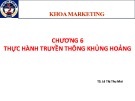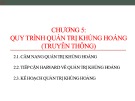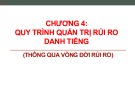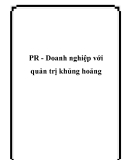
GS TS BS LÊ HOÀNG NINH

Truy n thông nguy cơ t t ề ố
Chuyển những kiến thức khoa học và kết quả đánh
giá nguy cơ thành các từ, cụm từ dễ hiểu
Giải thích rõ ràng biên dđộ không chắc chắn, các
thiếu hụt về kiến thức và việc triển khai các chương
trình nghiên cứu
Nêu rõ vấn đề nào là tin cậy và sự tin tưởng
Hiểu đúng các vấn đề nguy cơ công cộng đặc biệt
là xu thế , chiều hướng định tính

Truy n thông nguy cơ t t ( ề ố
t t)
Biết các vấn đề chuyên biệt có thể nổi lên trong
lãnh vực công cộng, cảm nhận của cộng đồng …
Phân tích các điều kiện cần để thông tin cho công
đồng và cơ hội tham gia cộng đồng

Những bước trong truy n ề
thông nguy cơ t tố
Chấp nhận những tranh luận khác/ trái chiều
Ask permission
Apologize
Clean up
Share (benefits or control)
Give credit where it is due

Truy n thông nguy cơề
Nhu cầu cần có
the message (information)
the source (origination point of message)
The communicator
the channel (path)
receiver (termination point)

![Bài giảng Quản trị khủng hoảng Trường Đại học Kinh tế Quốc dân [Mới nhất]](https://cdn.tailieu.vn/images/document/thumbnail/2025/20250721/hihihaha1/135x160/653_bai-giang-quan-tri-khung-hoang-truong-dai-hoc-kinh-te-quoc-dan.jpg)











![Đề thi kết thúc học phần môn Truyền thông trong kinh doanh [năm học mới nhất]](https://cdn.tailieu.vn/images/document/thumbnail/2025/20251015/dilysstran/135x160/93281760499390.jpg)


![Bài tập nhóm truyền thông marketing tích hợp [mới nhất]](https://cdn.tailieu.vn/images/document/thumbnail/2025/20250904/hakanami1502@gmail.com/135x160/90671756969236.jpg)





![Định vị doanh nghiệp: Bài thuyết trình [Mới nhất]](https://cdn.tailieu.vn/images/document/thumbnail/2025/20250813/vuthuhuyen1407/135x160/6261755072381.jpg)



